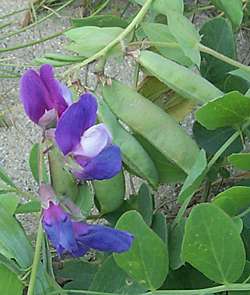Sea pea facts for kids
Quick facts for kids Sea pea |
|
|---|---|
 |
|
| Scientific classification | |
| Genus: |
Lathyrus
|
| Species: |
japonicus
|
| Synonyms | |
|
|
The sea pea (scientific name: Lathyrus japonicus) is also known by other names like beach pea or circumpolar pea. It is a type of legume plant. You can find it growing along the coasts in many parts of the world. This includes temperate areas of Asia, Europe, and North and South America.
This plant is a perennial herbaceous plant. This means it lives for many years and has soft, green stems instead of woody ones. Its stems can grow to be about 50 to 80 centimeters (about 20 to 31 inches) long. They often trail along sandy or gravelly beaches. The leaves are a waxy, grayish-green color and are 5 to 10 centimeters (about 2 to 4 inches) long. They are made up of 2 to 5 pairs of smaller leaflets, like a feather. The very last leaflet often turns into a curly tendril that helps the plant climb. The flowers are large and grow in clusters of up to twelve flowers. They have a dark purple top petal and lighter purple side and bottom petals.
Contents
What Does the Sea Pea Look Like?
The sea pea is a plant that comes back year after year. Its stem usually grows to be about 15 to 30 centimeters (6 to 12 inches) tall. The stem is soft, has no wings, and is often smooth. The leaves are arranged alternately along the stem. They are grayish-green and feel a bit thick or fleshy. They have very short stalks and large, wide stipules, which are small leaf-like parts at the base of the leaf stalk.
Leaves and Flowers
Each leaf is made up of three to five pairs of narrow, spear-shaped leaflets. These leaflets have blunt tips and smooth edges. At the end of the leaf, there is a curly tendril that helps the plant hold on to things. The plant's flower cluster grows on a long stem. It has five to twelve purple flowers. Each flower is about 14 to 20 millimeters (0.5 to 0.8 inches) long. As the flowers get older, their color changes to a bluer shade.
The flowers have five sepals (small leaf-like parts that protect the bud) and five petals. They have a special shape, with a large top petal, two side petals, and two bottom petals that are joined together. Inside the flower, there are ten stamens (the parts that make pollen) and one carpel (the part that makes seeds).
Fruit of the Sea Pea
After the flowers bloom, the plant produces a long, brown fruit. This fruit is a pod that can be up to 50 millimeters (about 2 inches) long. The sea pea typically flowers in the middle to late summer. This means July and August in places like North America and Europe. In places like South America, it flowers in January and February.
Where Does the Sea Pea Grow?
The sea pea is found naturally in temperate parts of Europe, Asia, North America, and South America. It usually grows on sandy or stony beaches and other places along the coast.
How Sea Pea Seeds Travel
The sea pea has a very wide natural range. This is because its seeds can float in sea water for up to five years and still be able to grow! This amazing ability allows the seeds to travel almost all over the world by ocean currents. When the hard outer coat of a seed gets rubbed down by waves on sand and gravel, it helps the seed to sprout and grow.
Uses of the Sea Pea
The pods of the sea pea can be eaten. However, like many plants in the Lathyrus family, they contain a special chemical. Eating too much of this chemical can cause a health problem that affects the nerves. Because of this, it's best not to eat large amounts of these pods. The leaves of the sea pea plant are also used in traditional Chinese medicine.

